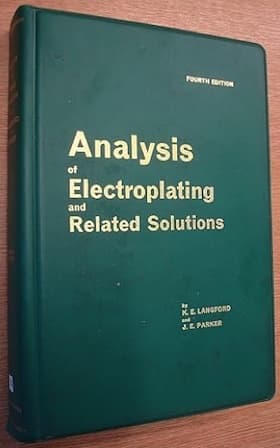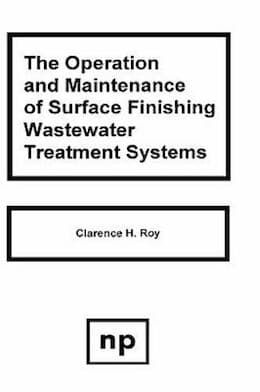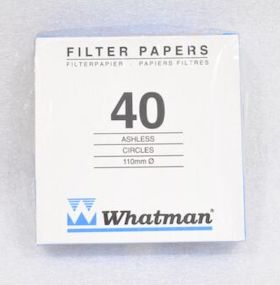
-----
Copper plating & chrome plating titration and analysis Q&A
Q. 1) Why is methyl orange
⇦ on
eBay or
Amazon [affil link]
indicator used in the titration to find conc. of H2SO4 in copper plating electrolyte ?
2) Why is Ammonium bifluoride used in the titration to find conc. of chromic Acid in Chrome plating electrolyte ?
3) Why is potassium iodide used in the titration to find conc. of chromic Acid in Chrome plating electrolyte ?
4) Why is starch is used in the titration to find conc. of chromic Acid in Chrome plating electrolyte?
5) Why is H2SO4 used in the titration to find conc. of chromic Acid in Chrome plating electrolyte?
plating shop employee - Rudrapur, Uttarakhand, India
June 9, 2010
|
|
"The Chemical Analysis of Electroplating Solutions"
by Terrance H Irvine  on eBay or Amazon or AbeBooks (affil link) A. You really need a good book on the subject :-) - Navarre, Florida A. 1) The methyl orange
⇦ on
eBay or
Amazon [affil link]
color change occurs at a convenient pH for the determination. There are others you could use that change color at a similar pH, but methyl orange
⇦ on
eBay or
Amazon [affil link]
is the one that is typically selected.  Jon Barrows, MSF, EHSSC Kansas City |
Q. 1) why are ammonium solution, ammonium purpurate and EDTA used to find the concentration of CuSO4 in copper plating electrolyte?
Komal Kumar [returning]- Rudrapur, Uttarakhand, India
![]() Hi, Komal. Please introduce yourself and comment on the responses you received. Few readers will enjoy having you simply proceed to administering a second round of this flash-card quiz :-)
Hi, Komal. Please introduce yourself and comment on the responses you received. Few readers will enjoy having you simply proceed to administering a second round of this flash-card quiz :-)
Regards,

Ted Mooney, P.E.
Striving to live Aloha
finishing.com - Pine Beach, New Jersey
Ted is available for instant help
or longer-term assistance.
Q. I'm so thankful to Mr. James Watts & Mr. Jon Barrows to provide the answers of my questions actually I work for plating shop but chemistry is not my strong subject.
Please provide the answers to my previous question.
- Rudrapur, Uttarakhand, India
|
|
"Analysis of Electroplating & Related Solutions"
by Langford & Parker  on Amazon or AbeBooks (affil link) A. Ammonia is used for complexing the copper ion so you have less interference from ions like iron. EDTA is a better complexer, so it will pull the copper from the ammonia complex. It also is a terrible end point to find if you do not have an indicator. The indicator that you mention also has a couple of trade names as well as a very specific chemical name. - Navarre, Florida A. Ammonium purpurate, more commonly known as murexide [affil link], is just an indicator that is common for complexometric titrations involving EDTA. The indicator, when bonded to the free metal ion in your solution, will be purple. When you titrate, the EDTA forms a more favorable complex with the metal ion and displaces the indicator from its complex. When all of the indicator has been displaced by the EDTA, you visually see the color change as a disappearance of purple. If it is important for you to understand these basic mechanisms of your titrations, then I would suggest you get a used textbook in quantitative chemical analysis in addition to the book that I have already mentioned. Older editions of textbooks can be found for very little money. Daniel C. Harris, 4th or 5th edition ⇦[this on eBay or Amazon or AbeBooks affil links] would be one acceptable reference.  Jon Barrows, MSF, EHSSC Kansas City |
A. I generally use PAN as an indicator in EDTA titrations of copper solutions. Nice, sharp endpoint.
It is helpful to, after the addition of the ammonia, to filter through Whatman #4 ⇦[this on
eBay or
Amazon affil links]
to get rid of the Fe(OH)3 before titrating. Makes the endpoint easier to see.

Dave Wichern
Consultant - The Bronx, New York
Q. I'm again thankful to Mr. James Watts & Mr. Jon Barrows
to provide the answers of my questions.
I have two more Questions Related to Nickel electrolyte titration.
1) why potassium chromate solution and silver nitrate solution
⇦ on
eBay or
Amazon [affil link]
are used to find the cons. of NiCl2 in Nickel plating electrolyte?
2) why mannitol powder, bromocresol purple
⇦ on
eBay or
Amazon [affil link]
and NaOH are used to find the conc. of Boric Acid in Nickel plating electrolyte?
Thanks in advance
- Rudrapur, Uttarakhand, India
A. Komal-
You really need to get some of those reference books...
1) Silver reacts with chloride ion to form an insoluble silver chloride which is a white precipitate that is seen as cloudiness. The silver also reacts with chromate to precipitate a red-orange silver chromate, but the reaction with chloride is thermodynamically favored which causes the chromate reaction to be put on hold until there is no more chloride left in the solution. So, once you see the permanent darker color in the precipitate begin to form, you know that your titration is complete.
2)Boric acid is a weak acid which means that it doesn't dissociate very well into acidic hydrogen cations and a borate anion. In order to perform an acid-base titration between boric acid and NaOH, we need to have acidic hydrogen ions. Mannitol is just the thing that gives that to us. It reacts with the boric acid to fully free up one of the three hydrogens in boric acid. We then titrate that free ion with NaOH. Bromocresol blue is just a color indicator that changes when the pH is high enough to signal that the reaction between the H+ and the OH- is complete. Good luck.

Jon Barrows, MSF, EHSSC
Kansas City
A. A side note to what Jon said. Make a solution of boric acid in DI water and let it set overnight. Very slowly titrate a sample of this with a 0.1N NaOH ⇦ on eBay or Amazon [affil link] solution with a pH meter. on the graph you will see 3 fairly distinct inflection points in the curve where each H comes off. In titrating the boric acid in the nickel solution, most of us go too fast and would drop out some of the nickel which would give a very false analysis. As Jon said, the manitol frees up the first H ion and it can be titrated reasonably rapidly. As you should have noticed, care must be taken to exactly duplicate an analysis. Ie, do not rush it. I used a tiny spin bar in a small beaker [beakers on eBay or Amazon [affil link] (25 mls) at a fairly high speed and a slow drip of the hydroxide. The great part about this analysis is that it does not have to be ultra accurate. Close is good enough.
James Watts- Navarre, Florida
Q. Hi,
I have a question related Effluent treatment.
Why below given chemicals are used in effluent treatment and how work individually?
1) polyelectrolyte
2) lime
3) calcium carbonate ⇦[this on
eBay or
Amazon affil links]
4) poly aluminium chloride
5) alum
6) caustic soda ⇦liquid caustic soda in bulk on
Amazon [affil link]
7) amol gazol
thanks
- Rudrapur, Uttarakhand, India
A. Hi, Komal.
• Polyelectrolyte helps to neutralize natural repulsive charges between particles and can also help as sort of a net to get precipitates to settle.
• Lime and/or caustic soda are two primary chemicals for neutralizing acidic waste; lime is cheaper and has additional powers to help wastewater treatment but is much more difficult to reliably control than caustic soda.
• Calcium carbonate is a co-precipitant, probably unnecessary if you use lime because lime also functions as one.
• Poly aluminum chloride and alum are settling/purifying aids and in some cases improve the action of polyelectrolyte and in some cases substitute for it.
• I've never heard of amol gazol -- what book mentions it?
by Clarence Roy

on eBay or Amazon
or AbeBooks
(affil link)
C'mon now, though, cousin! You admit that chemistry is your weak spot, and helpful readers have gently & politely told you 5 times now that in such a case you must get hold of a book on the subject lest you not even know what questions to ask with no framework. Authors spend months or years planning out their exact orders of presentation in tutorial fashion so that you can learn quickly, rather than bouncing back & forth between ideas you're not yet prepared for and stuff you've already seen a zillion times :-)
Continuing to administer yet a fourth round of a flash card quiz to the readers who have politely asked you not to isn't the best way forward :-)
Chemical analysis books have already been suggested; for the waste water treatment questions I would suggest Clarence Roy's "Operation and Maintenance of Surface Finishing Wastewater Treatment Systems" ⇨
or Kenneth Cherry's "Plating Waste Treatment" (if you can find one of them; maybe try WorldCat.org for a library holding it)
Good luck & Regards,

Ted Mooney, P.E.
Striving to live Aloha
finishing.com - Pine Beach, New Jersey
Ted is available for instant help
or longer-term assistance.
Q, A, or Comment on THIS thread -or- Start a NEW Thread
